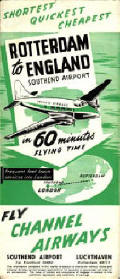
Other Factors
These days an accident in the circumstances leading to the loss of G-
The 'local' radar station at Thorney Island that could have provided vital navigational
assistance for a standard approach to Portsmouth, although not the landing itself,
did not operate on Sundays, the day of the accident, and Portsmouth Airfield had
no radio communications. Thus it was impossible to advise the crew of the current
weather conditions -
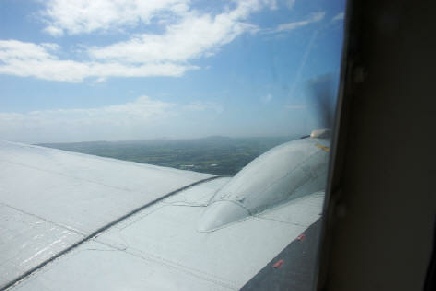
The Dakota was powered by two Pratt & Whitney 'Twin Wasp' engines.
Given the speed and nature of the impact, it was a miracle that there were any survivors at all. The skill of the flight crew in those final moments enabled some passengers to escape although with serious injuries.
The accident enquiry could find nothing technically wrong with the aircraft or altimeter
settings, although there was not much left to find as the aircraft was almost totally
destroyed and then burned out. However there is clear photographic evidence showing
at at least one of the main tyres was without tread and nearly worn out and there
have been disturbing and persistent rumours that the plane was well overdue for a
major overhaul although it had only recently joined the fleet after a major rebuild,
so this seems unlikely -
As the crew had requested a mid Channel descent to 1000 feet, their height and position appeared to have been intentional. The crash investigators asked a number of questions about the flight and the navigational information supplied by the airline as this appeared to be seriously out of date and incomplete, giving potentially misleading information about the use of radar on the approach to Portsmouth and the workings of the radio beacon system.
The fact that the radar was inoperative on Sundays -
The weather forecast was said by the crash investigators to have been accurate -
At the time, forecast visibility was about 500 -
There is no evidence that the Crew flew below the minimum permitted height over water, but if the wind was slightly stronger than expected, as has been postulated by a recent professional interpretation of the weather charts, this would have placed the plane nearer the island than expected if navigating on dead reckoning. They had no external navigation aid and the NDB at Thorney Island could not give an accurate indication at low altitude as transmissions were masked by the Island. Thus if they had come down to low level, believing they they would see the coast in good time, realised this was not so and were turning out to sea having given up the attempt at a let down, everything is in place to explain the crash. ( This is discussed in more detail at a later point ).

There is also the matter of pressure from the airline management on crews to fly. This is unseen, unheard and can affect careers, promotions and safety… and it still happens today. Many of the contacts we have had from professional readers have been about over tired crews and marginal weather. Don’t always believe the PR talk from the airlines, big or small.
Stranded and delayed passengers mean ill feeling, hotel bills, meals and a subsequent
backlog of flights as planes are out of position -
Would an experienced Captain who had flown the route over 90 times in the last year and had been described as meticulous, really have dropped to 1000 feet in an attempt to 'hedge hop' round the coast in a loaded airliner without a very good reason. What about the comments from passengers and yachtsmen in Portsmouth harbour about Channel planes making insanely low approaches in bad weather ? We can never know but it could paint an alarming picture of all the dots did happen to join up.
Perhaps the Captain just wanted to do his best for his passengers and get them home
after a long delay. That was what the Stewardess told the passengers just before
departure -
In this case there is no evidence at all, but there rarely is. It still happens
today -
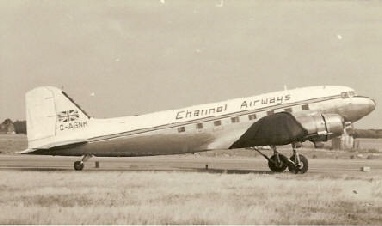
There had been official concern about the safety minima for bad weather operation
used by the airline. This had been 'under discussion' with the Ministry for some
time before the crash, but the matter was not concluded as officials were taken up
with the issue of the newly introduced Operator’s Licences and didn't get round to
following it up. This seems quite incredible today, but is another example of the
old boy network -
It might be argued that if the Airline's policy and operating limits had prevented
the flight leaving Southend in the weather conditions known to prevail at the time,
then the circumstances leading to the accident could not have arisen -
G-
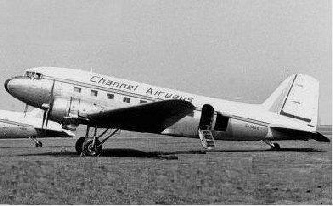
Another Channel DC3 waiting for her passengers at the beginning of another day on
the South Coast run. Note the different livery -
The enquiry took a very long time to report -
The Co-
In other cases , the damning finding of ' pilot error' has been claimed as expedient
because it may have implications for limiting claims by passengers and next of kin,
and without a very clear reason it is a catch all finding that can make further
responsibility very hard to determine and compensation difficult -
The Pilot certainly had an excellent reputation, was fully qualified on instruments
and very experienced, both on the DC3 and other heavy twin engine aircraft, so if
nothing else, maybe whatever went wrong on that day would have happened to any other
aircraft -
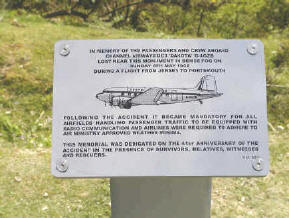
"Pilot error" is sometimes claimed to be an easy way out -
Perhaps it was just a ' pyramid of circumstances', one small factor leading to another, an unfortunate decision, a minor error, an unseen change, all building up until the flight crew were overwhelmed by circumstances.
Although the Captain, as 'pilot in command' was ultimately responsible for the safety of the plane which descended below a safe height in low cloud and hit a hill, perhaps in the circumstances prevailing he had no choice but to do as he did and just perhaps he based what he believed to be a perfectly safe flight plan on incorrect information.
We can never know if pressure was applied to make him try what appeared at the time to be the only safe way to reach the fog bound airstrip, or if his colleagues and the authorities then closed ranks in a masterful act of damage and liability limitation.
You may think he had a raw deal.
Thus while the intended destination might be impossible, other perfectly safe airports
were only a few minutes away, although in the wider scheme of things the decision
to send the flight out seems bizarre. Presumably train and coach fares on the mainland
were cheaper than hotel bills in the Channel Isles and inconvenience to low budget
passengers was not a major issue for airlines -
However the crew knew the route and Channel had been flying it for years without
accident, even if a few yachts had their masts trimmed, so the decision to go was
in some respects custom and practice. Weather like this around the Island is not
uncommon and it would be no issue -
While not applying hindsight, you may ask why a plane full of holiday makers was
ever sent out -
Channel planes flew in weather that grounded the other airlines on the South Coast
and as we have seen, the Air Ministry were already concerned about flying in such
poor visibility. There was a lot of correspondence and negotiation, but it would
seem that the Airline was slow to improve safety margins further than appeared strictly
necessary, and unfortunately although the authorities were prepared to write letters
and make abortive phone calls, they didn't actually do anything until it was too
late. Interestingly, and in the light of these ongoing discussions' with the Air
Ministry over weather minima, the airline were later at great pains to claim that
conditions at Portsmouth played no part in the accident -
The question that should have been asked was not 'why were Channel flying that day'
-
If one considers that the Ministry was actively involved in the incident, both regarding
flight operations, weather minima, operator and aircraft certification, and indirectly
the Met Office, it could be argued that they were investigating themselves! Perhaps
the conclusion was not altogether surprising -
Perhaps the most bizarre issue is that although much of the accident was blamed on the lack of radio at Portsmouth airfield, the flight time was not great and surely a phone call to ask someone to look out of the airport window would have prevented the whole issue…. Unless perhaps there were unseen forces determined to get the passengers to Portsmouth who regarded the bad weather as an inconvenience and reluctance on the part of the crew in the old RAF terms of ‘Lack of Moral Fibre’ . Could caution and prudence of the new breed of crews have been regarded as cowardice by the men who had flown bombers in the last War ? We can never know.
| Instruments |
| Visibility |
| Navigation |
| An Alternative Theory |
| Pressure On Crews |
| Blame |
